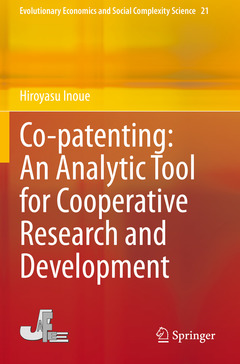Description
Co-patenting: An Analytic Tool for Cooperative Research and Development, 1st ed. 2020
A Network Science Approach
Evolutionary Economics and Social Complexity Science Series, Vol. 21
Author: Inoue Hiroyasu
Language: English
Subjects for Co-patenting: An Analytic Tool for Cooperative Research...:
Co-patenting: An Analytic Tool for Cooperative Research and Development
Publication date: 01-2021
114 p. · 15.5x23.5 cm · Paperback
Publication date: 01-2021
114 p. · 15.5x23.5 cm · Paperback
Predicting the Impact of Patents
Publication date: 01-2020
114 p. · 15.5x23.5 cm · Hardback
Publication date: 01-2020
114 p. · 15.5x23.5 cm · Hardback
Description
/li>Contents
/li>Biography
/li>Comment
/li>
This is the first book that comprehensively analyses co-patenting in Japan and the U.S., which directly signifies collaborations between firms and inventors, using the methodology of network science. Network science approaches enable us to analyse the structures of co-patenting networks. In addition, generative models in network science estimate the probability of new connections between nodes, which enables us to discuss the temporal development of networks. On the other hand, regression analyses, which are broadly used in the field of economics, may be effective for determining what attributes are important for firms and inventors that are going to be connected, but such techniques cannot consider the complexity of networks. This book compiles a series of studies by the author on geographical location and co-patenting using data that were published in eight academic journal articles. This book gives the reader ideas about how we can utilize patent data to understand how firms and inventors collaborate under the effect of complex networks.
Introduction.- Collaboration networks on inventors and firms.- The innovator’s dilemma in collaboration.- Agglomeration of establishment location.- Agglomeration of establishment co-authorship.- Community of establishment networks.- Generative model: Distance and past connection.- Generative model: Intertexture of firm and inventor.
Hiroyasu Inoue, Graduate School of Simulation Studies, University of Hyogo, Kobe, Japan
Within the methodology of network science, comprehensively analyses the co-patenting in Japan and the U.S. that directly signifies collaborations between firms and inventors Reveals the geographical and temporal characteristics and community structures of the co-patenting network Provides models that estimate the probability of new connections between firms and inventors
© 2024 LAVOISIER S.A.S.




